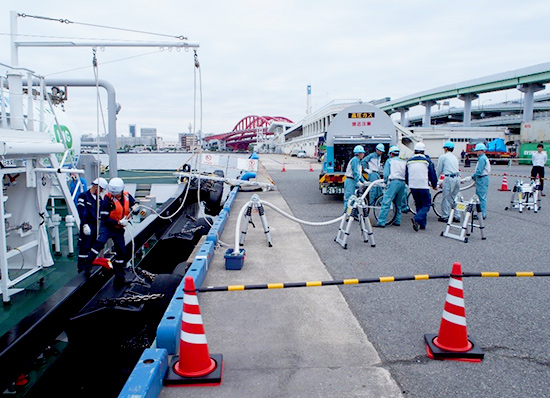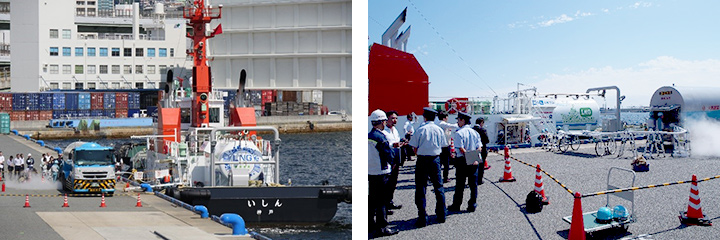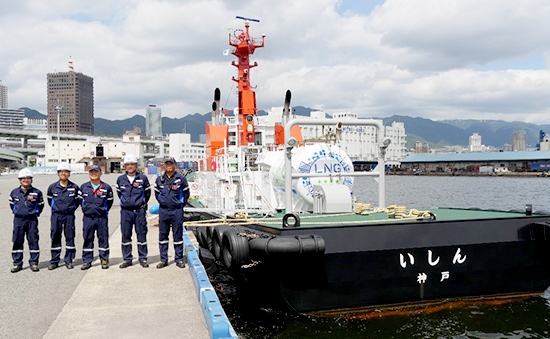- JP
- EN
LNG-fueled Tugboat Ishin Undergoes 1st LNG Bunkering Trial in Port of Kobe
- Contributing to Development of LNG Bunkering Ports and Wider Use of LNG as Marine Fuel -
September 18, 2019
TOKYO-Mitsui O.S.K. Lines, Ltd. (MOL; President & CEO: Junichiro Ikeda) announced that it has participated in the LNG bunkering trial at the Port of Kobe today, organized by the Kobe City Port and Harbor Authority, and carried out bunkering on the LNG-fueled tugboat Ishin (Note 1). Ishin is a tugboat owned by MOL and operated by Nihon-Tug-Boat Co., Ltd. (President: Tetsuro Nishio, Headquarters: Chuo-ku, Kobe). This marks the first LNG bunkering in the Port of Kobe, and the successful trial confirmed that LNG fuel can be effectively supplied safely at the port.
LNG fuel for the trial was hauled by a tanker truck from the Himeji LNG Plant (Himeji-shi, Hyogo Prefecture) of Osaka Gas Co., Ltd. (President: Takehiro Honjo, Headquarters: Chuo-ku, Osaka), and, via a truck-to-ship system (Note 2), was used to supply Ishin, berthed at Kobe Port's Shinko Pier No.4. MOL Marine Co., Ltd. (President: Toshikazu Inaoka; Headquarters: Minato-ku, Tokyo) has also provided maritime consulting in the trial.
Effective January 2020, vessel exhaust emission regulations will be tightened on a global scale. (Note 3) In response to the new standards, an increasing number of LNG-fueled vessels are coming into service, making the development of LNG bunkering ports in Japan an urgent task. MOL Group companies are working together to promote the wider adoption of LNG fuel for vessels (Note 4) and reduce environmental impact through the safe operation of Ishin.

Vessel-side and shore-side working together to connect bunkering hose

LNG fuel bunkering

Ishin and the crews
(Note 1) For details, please refer to the February 28, 2019 press release:
MOL Holds Delivery Ceremony for LNG-fueled Tugboat Ishin.
The Ishin's excellent environmental performance – including an estimated 25% reduction in CO2 emissions in comparison to tugs that run on A fuel oil – earned the top rating of four stars from the Ministry of Land, Infrastructure, Transport and Tourism's energy-saving rating program for Japan's costal ships.
Outline of Ishin
| Gross tonnage | About 250 tons |
|---|---|
| LOA | About 43.6m |
| Breadth | About 9.20m |
| Draft | About 3.15m |
| Speed | 16.0 knots + |
| Main engine | Two Yanmar 6EY26DF dual-fuel commercial marine engines |
(Note 2) A truck-to-ship LNG bunkering procedure. Fuel is supplied from an LNG truck to a moored vessel.
(Note 3) Regulations to prevent air pollution from vessels were established in Annex VI issued in 2005 in the MARPOL Treaty adopted by the International Maritime Organization (IMO). Since then, exhaust gas regulations have become more stringent worldwide. Starting in January 2020, the limit for sulfur in fuel oil used on board ships operating outside designated emission control areas will be reduced to less than 0.50% m/m.
(Note 4) MOL established the Bunker Business Office to accelerate its initiatives on LNG and other alternative vessel fuels, and is taking an integrated approach to entering the business of supplying LNG and other fuels. For details, please refer to the press release on February 24, 2017:
MOL to Restructure Organization
